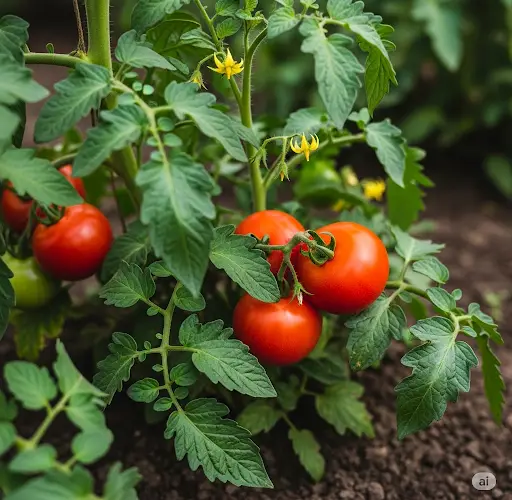If you’ve ever struggled with small tomato harvests, stunted plants, or poor fruit development, you’re not alone. Tomatoes are heavy feeders, and their root systems need a strong nutritional foundation to support lush foliage, healthy blossoms, and heavy fruiting. One of the best gardening lessons I’ve learned — though I wish I had discovered it sooner — is this: what you put into the planting hole makes all the difference.
After making one simple change during planting season, my tomato plants began to thrive like never before. Now I harvest bucketloads of tomatoes, and my plants stay healthy and productive all season long. The secret? A combination of natural ingredients added directly into the planting hole before transplanting tomato seedlings.
Let’s dive into what to add, why it works, and how to use this method for your best tomato harvest yet.
Why the Planting Hole Is So Important
When you transplant tomato seedlings into the garden, you have a rare opportunity to feed the roots right where they need it most. Most gardeners focus on fertilizing after the plant is already growing — but setting the stage from the very beginning gives your tomatoes a powerful advantage.
A well-prepared planting hole:
-
Provides immediate access to nutrients
-
Encourages fast root development
-
Improves soil texture and drainage
-
Reduces transplant shock
-
Supports better flowering and fruit production later
The Winning Tomato Hole Mix: What to Add
Here’s the simple, all-natural mix I now add to every tomato hole:
1. A Handful of Compost or Aged Manure
-
Why it helps: Adds essential nutrients and beneficial microbes.
-
How much: About 1/2 to 1 cup per hole.
-
Tip: Well-rotted cow or horse manure is ideal. Avoid fresh manure, which can burn young roots.
2. 1 Teaspoon of Bone Meal
-
Why it helps: Bone meal is rich in phosphorus and calcium — crucial for root development and fruit formation.
-
How much: 1 teaspoon per planting hole, mixed into the soil at the base.
3. 1 Teaspoon of Wood Ash or Crushed Eggshells
-
Why it helps: Adds potassium and calcium, which help prevent blossom end rot and improve overall fruit quality.
-
Tip: If using eggshells, crush them finely for faster breakdown.
4. A Small Scoop of Worm Castings (Optional)
-
Why it helps: Adds beneficial microbes and gentle, balanced nutrients.
-
Bonus: Improves soil texture and moisture retention.
5. A Sprinkle of Mycorrhizal Fungi (If Available)
-
Why it helps: Encourages symbiotic root relationships, improving nutrient and water uptake.
-
Use: Dust the roots before planting, or sprinkle into the planting hole.
How to Use the Mix – Step by Step
-
Dig a deep hole — tomatoes love to be planted deeply, with most of the stem buried to encourage strong root growth.
-
Place the amendments — layer in your compost, bone meal, ash/eggshells, and any optional ingredients.
-
Lightly mix with the soil — don’t leave the ingredients in a pile; blend them into the bottom soil so they’re evenly distributed.
-
Water the hole lightly before placing your seedling.
-
Place your tomato plant in the hole, burying two-thirds of the stem.
-
Backfill with soil, press down gently, and water thoroughly.
The Results: Healthier Plants, Bigger Yields
After switching to this method, here’s what I noticed in my garden:
-
Faster root establishment — plants took off quickly and didn’t wilt after transplanting.
-
Stronger stems and darker leaves — a clear sign of good nitrogen and phosphorus uptake.
-
Earlier and more abundant flowering
-
Larger fruits and heavier yields
-
Virtually no blossom end rot or nutrient deficiencies
I now use this method not only for tomatoes but also for peppers and eggplants — with equally impressive results.
Extra Tips for a Huge Tomato Harvest
-
Mulch generously to retain moisture and suppress weeds.
-
Water deeply and consistently — avoid overhead watering and try to keep soil evenly moist.
-
Prune lower leaves to improve air circulation and reduce disease risk.
-
Support your plants early with sturdy cages or trellises to avoid breakage as fruit develops.
-
Side-dress with compost or tomato fertilizer once flowering starts.
Final Thoughts
Tomatoes may be demanding, but they reward you generously when given the right start. A few natural additions to each planting hole can completely transform your harvest, making the difference between a handful of fruits and an overflowing basket.
I only wish I had learned this simple method earlier. If you’re planting tomatoes this season, don’t skip this step — your plants will thank you with a bountiful crop of juicy, flavorful tomatoes you can enjoy all summer long.



